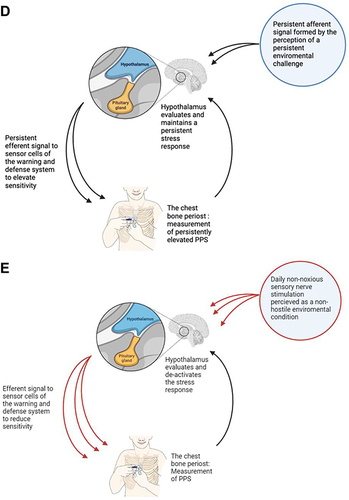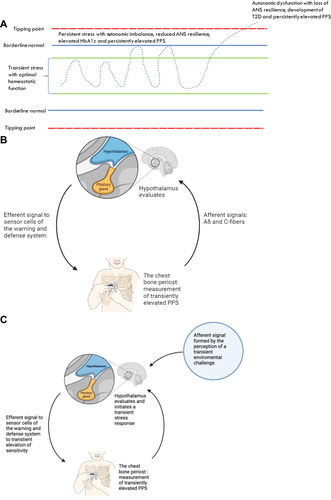Figures & data
Figure 1 The proposed link between stress, autonomic nervous system (ANS) function, PPS, and autonomic homeostatic regulation of glucose metabolism. Effect of reversal of ANS dysfunction. (A) Autonomic homeostatic control of glucose metabolism (HbA1c) and warning and defense system sensitivity (PPS). Inspired by Goldstein et alCitation19 (B) Autonomic homeostatic control by an autonomic reflex arc, regulation of PPS. 1) an afferent signal generated from polymodal sensor cells on periosteum of sternum initiates an afferent signal to hypothalamus for warning and defense system regulation; 2) modulation by the brain in the lateral horn of hypothalamus,Citation19 and 3) efferent sympathetic neural signals for adaptation, including the periosteal pressure sensitivity measured as PPS.; 4) The reflex arc for regulation of glucose metabolism is structured the same way with afferent signals coming from glucose sensors. (C) Autonomic homeostatic control in transient stress. 1) an afferent signal to hypothalamus in response to the perception of a transient stress condition (e.g, an emotional challenge/physical threat/mental demand); 2) hypothalamus initiates a transient physiological stress response, which leads to 3) transient increase in PPSCitation20 and transient increase in insulin release from pancreas, transient increase in insulin levels in blood to facilitate transport of glucose into the cells, and transient increase in blood glucose to meet transient increase in demand of glucose in the cells. For simplicity, the figure shows the situation for PPS, only. (D) A persistent perception of stress leading to gradual loss of ANS resilience and ANS homeostatic power bringing forward the situation of autonomic dysfunction.Citation21 If this condition persists, it may pass the ANS tipping point for internal regulation as shown in (A), which is associated with loss of autonomic homeostatic control of the sensitivity of the warning and defense system, measured as persistently elevated PPS. In addition, autonomic homeostatic control of glucose metabolism is also lost,Citation10,Citation19 resulting in the development of type 2 diabetes. A vicious circle is established as ANSD itself is disease worsening. For simplicity, the figure shows the situation for PPS, only. (E) Regaining autonomic homeostatic control by reversal of ANSD mediated by repetitive activations of the autonomic reflex arc, including the following steps: 1) Non-noxious sensory nerve stimulation for 30–60 seconds of a tender spot on the body surface related to spinal cord thoracic segments T3-T5 (ie, a hypersensitive polymodal sensor cell) and identified by finger-palpation;Citation12 2) transmission of the signal through A-delta and C-nerve fibers to the spinal cord and forward to the hypothalamus; 3) the signal is evaluated by hypothalamus as non-hostile, leading to 4) an efferent descending signal to the periosteum of the sternum reducing the elevated sensitivity of the warning and defense system, which is measured acutely as reduced tenderness by the finger and a reduced PPS. 5) the steps 1–4 are repeated twice daily for 6 months and the person experiences this as a gradual decrease of the initially elevated PPS. The normal autonomic homeostatic regulation of glucose metabolism is gradually reestablished, and a concomitant reduction of HbA1c can be measured after 6 months.

Table 1 Baseline Characteristics of Randomized Participants
Table 2 Effect of Intervention (Mean (SD), Median [Interquartile Range], per Protocol, n = 52 Active; n = 60 Controls
Data Sharing Statement
The data presented in the current study are available from the corresponding author upon request.

